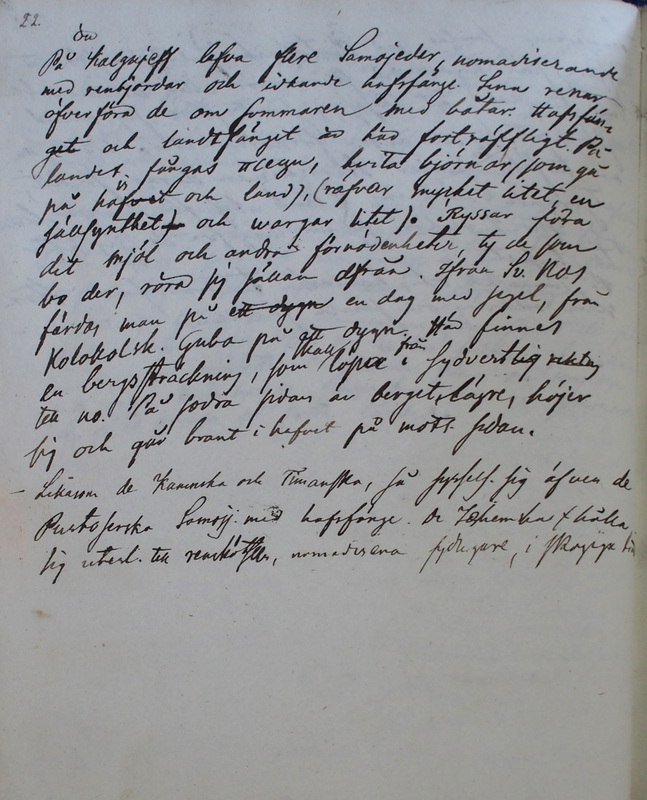Ethnographiska, historiska och statistiska anmärkningar. 022
Title
Ethnographiska, historiska och statistiska anmärkningar. 022
Description
| På ön
Kolgujeff
lefva flere Samojeder, nomadiserandeKolguev (TN Холгов). Castrén’s knowledge represents a typical example of second-hand information on Kolguev, which as an island was seldom visited by outsiders. Nenets families had possibly already moved to the island in the late 18th century, but during the 19th, several families definitely settled on Kolguev. Moving onto the island and living there was based on mutual relations with Russian merchants and Pomors, with whom the Nenets had contracts over herding reindeer and trade. (Lepëchin 1805: 193–196 Trevor-Battye 2004; Podekrat 1936: 73; Chomič 1966: 17, n11; Lukin 2011: 25–33)
med renhjordar och idkande hafsfånge. Sina renar öfverföra de om sommaren med båtar. Hafsfån- get och landsfånget är här forträffligt. På landet fångas псеци, hvita björnar (som gå på hafvet och land), (räfvar mycket litet, en sällsynthet och wargar litet.) Ryssar föra dit mjöl och andra förnödenheter, ty de som bo der, röra sig sällan d[eri]från. Ifrån Sv[jatoi]. Nos fördas man på en dag med segel, från Kolokolsk[aja]. Guba på ett dygn. Här finnes en bergsträckning, som löper från sydvest till no[rr]. På södra sidan är berget lägre, höjer sig och går brant i hafvet på mots[att]. sidan. |
On the island of Kolguev there are several living, nomadising with reindeer herds and practising sea hunting. They transfer the reindeer by boats in the summer. Sea and land hunting is rewarding here. On the land, they hunt Arctic foxes, polar bears (which walk on the sea and land), very few foxes, which are a rarity, and a few wolves. The Russians bring flour and other necessities there, as those who live there rarely travel away [to the mainland]. One can go there in a day by sailing from Svjatoi Nos, 24 hours from Kolokolskaja Guba. There is a mountain range running from the south-west to the north. It is lower on the southern side of the mountains, where the mountain is lower; on the opposite side the land rises and goes steeply into the sea. |
| Likasom de Kaninska och Timanska, så syssels[ätta]. sig äfven de Pustoserska Samojj[eder]. med hafsfånge. De Ishemska
hållaRu ižemskie samojedy ʻIžma Nenets’ (Dronova & Istomin 2003; Habeck 2005) See [Kaninska].
sig utesl.[uteslutande] till renskötseln, nomadisera sydligare, i skogiga trakten. |
Similarly to the Kanin and Timan [Samoyeds], the Pustozersk Samoyeds also practise sea hunting. The Ishem [Samoyeds] keep themselves only by herding reindeer, and nomadise in more southern, wooded areas. |

